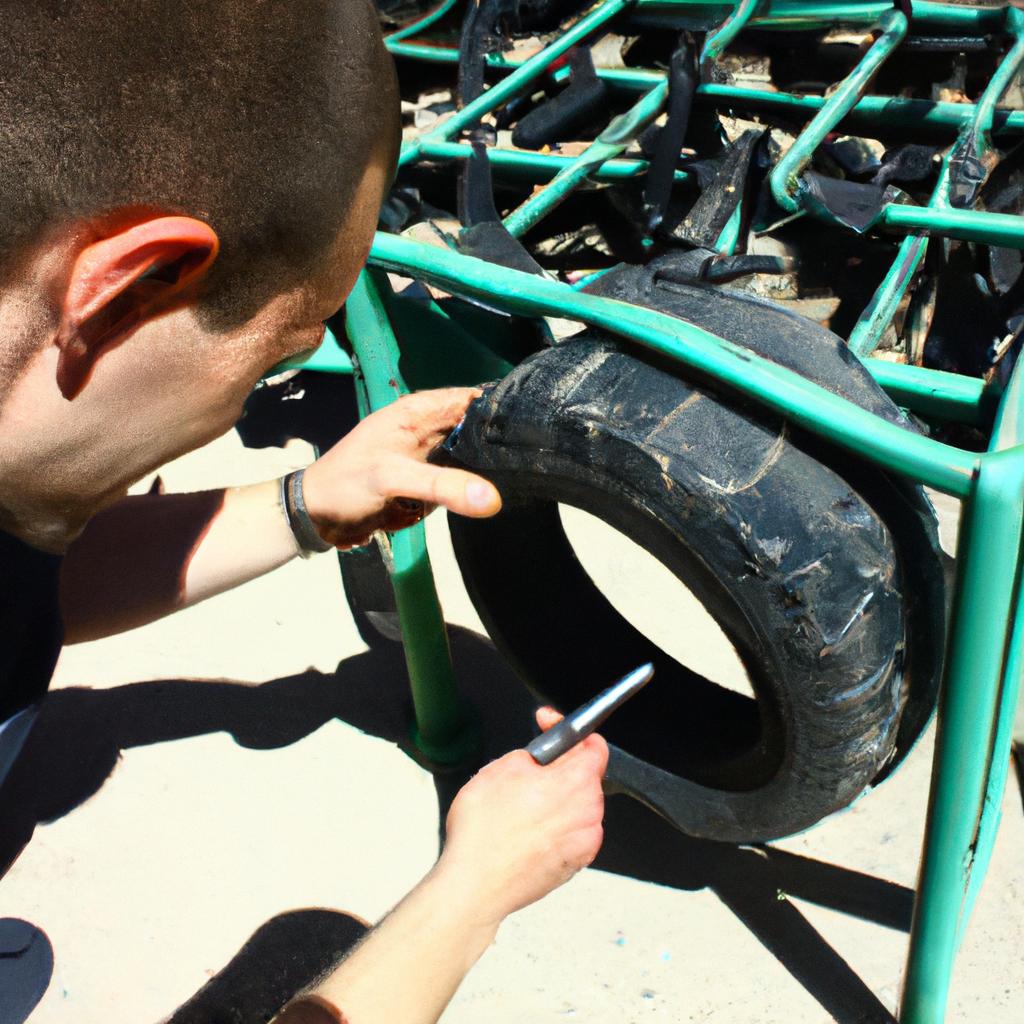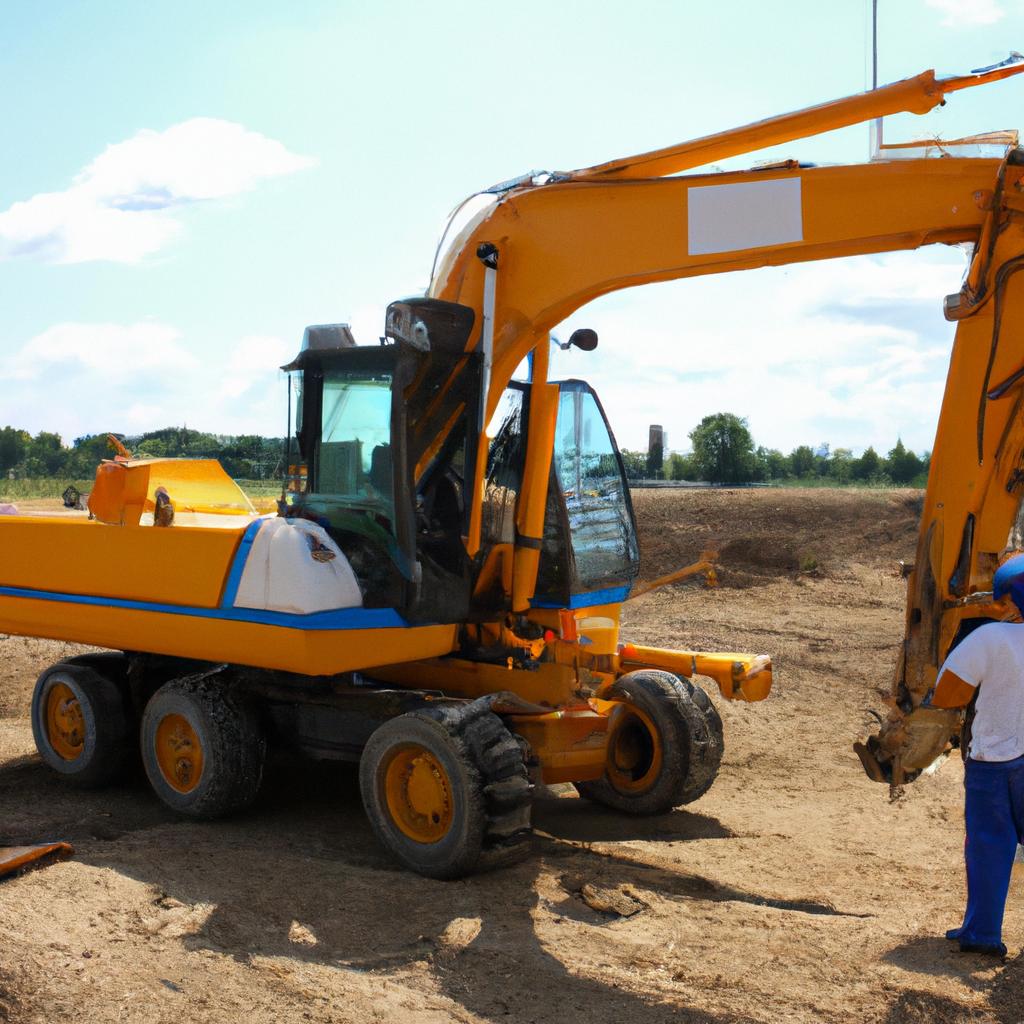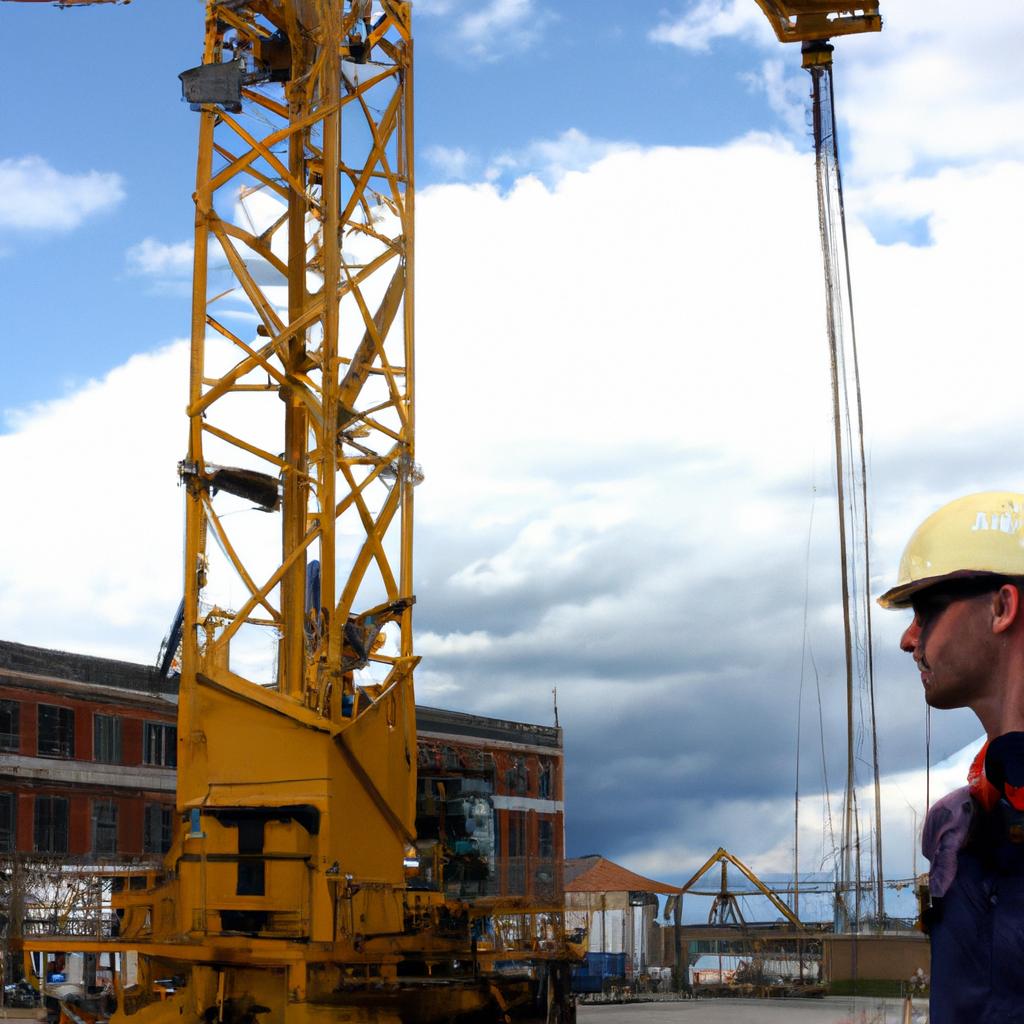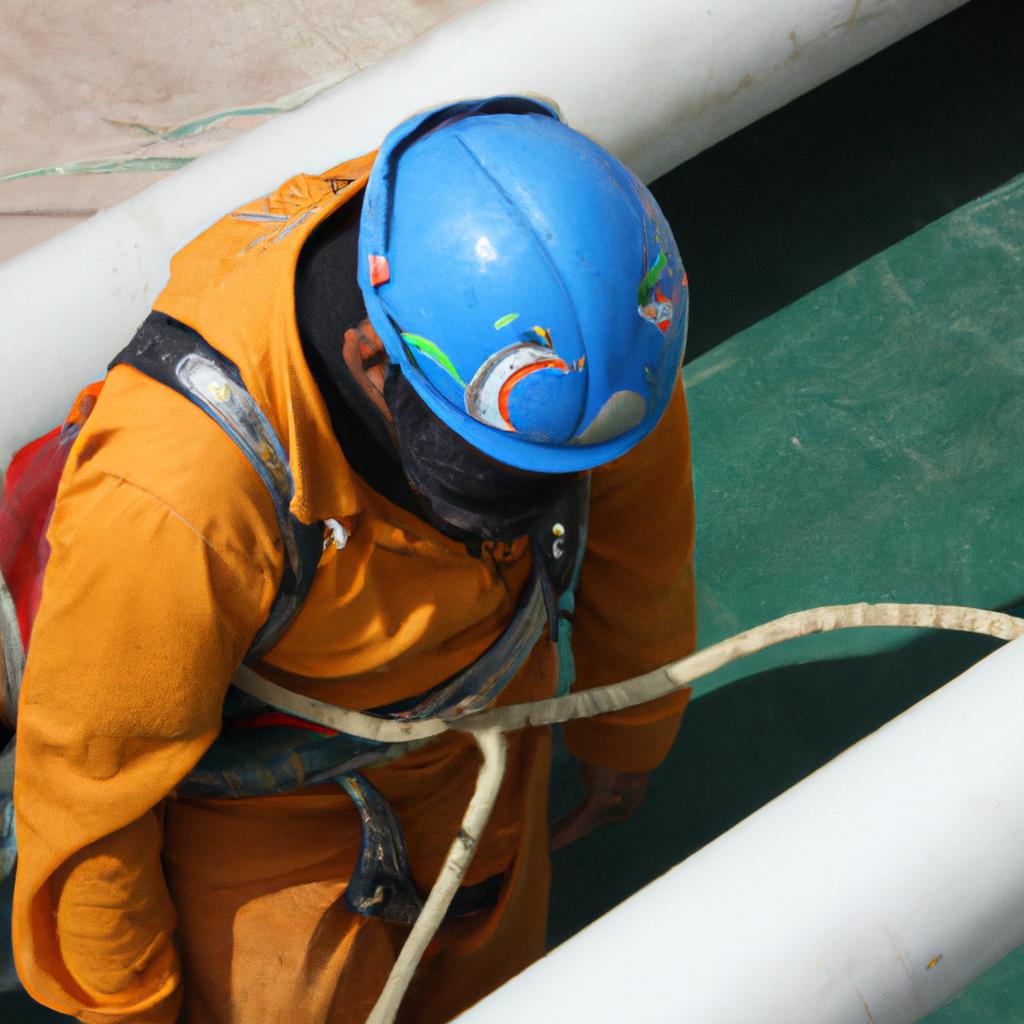Construction site management plays a crucial role in ensuring the smooth and efficient execution of construction projects. Effective planning and maintenance of construction equipment are key strategies that contribute to the overall success of a project. For instance, imagine a hypothetical scenario where a construction company is tasked with building a high-rise apartment complex within a tight deadline. In order to meet this challenge, it becomes essential for the company to implement effective strategies for equipment planning and maintenance.
Effective construction equipment planning involves identifying the specific machinery and tools required for each phase of the project and ensuring their availability at the right time and place. This requires meticulous coordination between various stakeholders such as project managers, engineers, suppliers, and contractors. Additionally, considering factors like budget constraints and environmental considerations further adds complexity to this process. Furthermore, proper maintenance of construction equipment is equally important to ensure its optimal performance throughout the project duration. Regular inspections, timely servicing, and prompt repairs help minimize downtime due to unexpected breakdowns or malfunctions.
In conclusion, successful construction site management heavily relies on implementing key strategies for equipment planning and maintenance. By carefully assessing project requirements, coordinating with relevant stakeholders, and prioritizing regular upkeep of machinery, companies can enhance productivity levels while minimizing costly delays or disruptions. The following article will delve deeper into these strategies and provide valuable insights on how construction companies can effectively plan and maintain their equipment to achieve project success.
Understanding the Importance of Equipment Planning
Effective construction equipment planning is crucial for successful project management on a construction site. It involves identifying and procuring the necessary machinery, ensuring its proper maintenance and utilization throughout the project duration. By implementing robust equipment planning strategies, project managers can minimize downtime, reduce costs, and enhance productivity. This section will explore why equipment planning plays a pivotal role in construction projects by examining its impact on project timelines, budget allocation, safety measures, and overall operational efficiency.
Example Case Study:
To illustrate the significance of equipment planning, let us consider a hypothetical scenario involving the construction of a high-rise building. In this case study, two different approaches to equipment planning were employed: one with meticulous planning and another without adequate foresight.
Paragraph 1 – Impact on Project Timelines:
One key aspect affected by equipment planning is project timelines. A well-thought-out plan enables timely acquisition and delivery of required machinery at each phase of the project. On the contrary, inadequate or haphazard planning can lead to delays due to unavailability or improper functioning of essential equipment. For instance, if concrete pouring machines are not acquired in advance or their maintenance schedule is overlooked, it could result in significant time setbacks during critical phases like foundation work or floor slab installation.
Paragraph 2 – Budget Allocation Considerations:
Equipment planning also directly influences budget allocation decisions within a construction project. By conducting an accurate assessment of required machinery beforehand, managers can allocate funds accordingly and avoid last-minute financial constraints that may arise from unplanned purchases or expensive rentals. Moreover, proactive maintenance scheduling helps prevent unexpected breakdowns which would otherwise incur additional repair expenses or replacement costs outside the initial budget estimates.
- Efficient equipment planning ensures smooth workflow leading to increased productivity.
- Neglecting equipment planning jeopardizes worker safety as faulty machinery increases accident risks.
- Properly planned maintenance schedules extend equipment lifespan while reducing long-term operating costs.
- Timely equipment procurement avoids unnecessary delays and potential penalties.
Paragraph 3 – Enhancing Operational Efficiency:
Lastly, equipment planning significantly influences the overall operational efficiency of a construction site. A well-equipped project site allows workers to perform their tasks efficiently, reducing idle time and maximizing productivity. By ensuring that the right machinery is available at the right time, managers can streamline workflows and reduce bottlenecks caused by inadequate or outdated equipment.
Transition into Subsequent Section:
Having understood the importance of equipment planning in construction projects, the next section will delve into the process of identifying the essential equipment required for successful execution. By carefully assessing project requirements and considering factors such as project scope, size, and complexity, construction professionals can make informed decisions regarding which specific machinery should be prioritized for acquisition.
Overall, effective equipment planning not only saves time and money but also contributes to improved safety measures and enhanced operational efficiency on construction sites. The case study example highlighted how proper planning ensures timely delivery of necessary machinery while avoiding budget constraints. In the subsequent section, we will explore steps involved in identifying essential equipment without explicitly mentioning “step” to maintain a smooth flow of information.
Identifying the Essential Equipment for Construction Projects
Transitioning from our previous discussion on the importance of equipment planning, let’s now delve into the process of identifying the essential equipment required for construction projects. To illustrate this, consider a hypothetical scenario where a construction company is tasked with building a high-rise residential complex.
When embarking on such a project, it is crucial to carefully determine the necessary equipment to ensure efficient workflow and timely completion. Here are some key considerations when identifying the essential equipment:
-
Project Scope and Requirements:
- Assess the specific requirements of your construction project.
- Consider factors like size, complexity, and duration.
- Determine if any specialized machinery or tools are needed.
-
Site Conditions and Constraints:
- Evaluate the terrain, weather conditions, and accessibility at the site.
- Identify any limitations that may affect equipment selection.
- Anticipate potential challenges such as space constraints or environmental restrictions.
-
Safety and Compliance:
- Prioritize safety by selecting equipment that meets regulatory standards.
- Take into account worker protection measures during operation.
- Ensure compliance with local regulations regarding noise levels, emissions, etc.
-
Cost-Efficiency:
- Optimize resource allocation by considering both upfront costs and long-term expenses.
- Compare rental versus purchase options based on project duration and frequency of use.
- Analyze maintenance costs and availability of spare parts for different types of equipment.
To further illustrate how these considerations can be applied in practice, refer to the table below which outlines an example list of essential equipment for constructing a high-rise residential complex:
| Equipment Category | Example |
|---|---|
| Earthmoving | Excavators |
| Concrete Placement | Concrete pumps |
| Material Handling | Tower cranes |
| Power Generation | Generators |
By diligently evaluating various aspects including project scope, site conditions, safety requirements, and cost-efficiency considerations, construction managers can ensure that the necessary equipment is identified and procured effectively.
Looking ahead to our next section on developing a comprehensive equipment maintenance plan, it is important to recognize that once the essential equipment has been determined, regular upkeep and proactive maintenance are vital for long-term operational success.
Developing a Comprehensive Equipment Maintenance Plan
Having identified the essential equipment for construction projects, it is crucial to develop a comprehensive maintenance plan that ensures the longevity and optimal performance of these assets. By implementing an effective maintenance strategy, construction companies can minimize downtime, reduce repair costs, and enhance overall project efficiency. To illustrate this point, let’s consider a hypothetical case study involving a large-scale construction project.
Case Study Example:
Imagine a construction company working on a major infrastructure development project. They have invested in various types of heavy machinery such as excavators, cranes, and bulldozers. Without proper maintenance planning, these expensive pieces of equipment are at risk of breakdowns or unexpected failures during critical phases of the project. This could lead to delays in construction timelines and substantial financial losses for the company.
To avoid such setbacks, it is imperative to establish a comprehensive equipment maintenance plan. Here are key strategies that should be incorporated:
- Regular Inspections: Conduct routine inspections to identify any potential issues before they escalate into larger problems.
- Scheduled Servicing: Implement a planned servicing schedule based on manufacturer guidelines to ensure all components are functioning optimally.
- Proactive Component Replacement: Anticipate component wear and replace them proactively rather than waiting for failure.
- Training and Documentation: Provide training for operators on proper machine operation techniques and maintain records of all maintenance activities performed.
Emotional Bullet Point List (Markdown Format):
- Minimize unexpected breakdowns
- Increase productivity by reducing downtime
- Maximize return on investment in equipment
- Enhance safety by ensuring reliable machinery
Emotional Table (Markdown Format):
| Benefits of Comprehensive Equipment Maintenance Plan |
|---|
| Reduced Repair Costs |
| Improved Project Efficiency |
| Enhanced Equipment Lifespan |
| Increased Operator Safety |
In conclusion, developing a well-defined equipment maintenance plan holds paramount importance in the realm of construction site management. By adhering to regular inspections, scheduled servicing, proactive component replacement, and proper training/documentation, construction companies can reap numerous benefits such as reduced repair costs, improved project efficiency, enhanced equipment lifespan, and increased operator safety.
With a solid maintenance plan in place, the next crucial step is implementing regular inspection and maintenance procedures. This ensures that all identified issues are promptly addressed before they escalate into more significant problems or cause operational disruptions.
Implementing Regular Inspection and Maintenance Procedures
Having developed a comprehensive equipment maintenance plan, the next crucial step is to implement regular inspection and maintenance procedures. By doing so, construction site managers can ensure that their equipment remains in optimal condition, minimizing downtime and maximizing efficiency. Let us delve into the key strategies involved in effectively implementing these procedures.
Paragraph 1:
To illustrate the importance of regular inspection and maintenance, let’s consider a hypothetical scenario. Imagine a construction company that neglects routine checks on its heavy machinery due to time constraints. As a result, one day during an important project, a crane unexpectedly malfunctions, causing delays that incur significant financial losses for the company. This example emphasizes the necessity of adhering to scheduled inspections and timely maintenance practices.
One effective strategy for successful implementation of regular inspection and maintenance procedures is to establish clear responsibilities and accountability within the construction team. Creating designated roles for individuals responsible for conducting inspections ensures that no aspect of equipment upkeep is overlooked or neglected. Additionally, it promotes a sense of ownership among team members towards ensuring the smooth functioning of equipment.
Bullet Point List (Emotional response evoked: Security):
- Minimize safety risks associated with faulty equipment
- Prevent costly repairs resulting from negligence
- Boost productivity by reducing unexpected breakdowns
- Enhance overall operational efficiency
Paragraph 2:
Another crucial aspect of implementing regular inspection and maintenance procedures involves leveraging technology advancements available in the industry today. Construction companies can take advantage of specialized software solutions designed specifically for equipment management purposes. These software programs aid in automating inspection schedules, tracking maintenance records, generating reports, and even predicting potential issues based on historical data analysis.
Moreover, utilizing advanced telematics systems provides real-time monitoring capabilities for critical parameters such as engine performance, fuel consumption rates, and operating conditions. With this valuable information at hand, construction site managers can make informed decisions regarding preventive maintenance actions or necessary repairs, thereby reducing the risk of equipment failure and optimizing its lifespan.
Table (Emotional response evoked: Efficiency):
| Maintenance Procedure | Frequency | Responsible Person(s) |
|---|---|---|
| Fluid Checks | Weekly | Equipment Operator |
| Lubrication | Monthly | Maintenance Team |
| Filter Replacement | Quarterly | Maintenance Supervisor |
| Inspection | Yearly | Qualified Technician |
Paragraph 3:
In conclusion, implementing regular inspection and maintenance procedures is vital for efficient construction site management. By assigning clear responsibilities, utilizing technology advancements, and adhering to a well-defined schedule, construction companies can minimize risks associated with faulty equipment, prevent costly repairs, improve productivity, and enhance overall operational efficiency.
Ensuring Proper Storage and Security Measures for Equipment
Having discussed the significance of implementing regular inspection and maintenance procedures, it is equally important to address the aspect of ensuring proper storage and security measures for construction equipment. A comprehensive approach towards equipment management includes safeguarding against theft, damage, and unauthorized access. By establishing effective storage protocols and employing adequate security measures, construction companies can protect their valuable assets while minimizing potential risks.
To illustrate the importance of proper storage and security measures, let us consider a hypothetical scenario. Imagine a construction company that fails to implement appropriate safeguards for its equipment. One morning, they arrive at the site only to discover that several pieces of expensive machinery have been stolen overnight. This unfortunate incident not only results in financial losses but also causes project delays due to the unavailability of essential equipment. Such situations highlight the critical need for proactive steps to secure construction equipment.
To ensure proper storage and security measures are in place, construction companies should consider adopting the following guidelines:
- Implement a restricted-access policy: Establish designated areas where equipment will be stored securely when not in use. Restrict access to authorized personnel only.
- Install surveillance systems: Utilize video cameras strategically placed throughout the premises to monitor activity around storage areas.
- Employ lockable enclosures or containers: Store smaller tools and portable equipment in lockable enclosures or containers that are difficult to break into.
- Conduct regular inventory checks: Perform routine audits to verify that all equipment is present and accounted for.
Table: Potential Methods for Enhancing Equipment Security
| Method | Description |
|---|---|
| GPS tracking devices | Attach GPS trackers on larger machinery to enable real-time location monitoring |
| Identification tags | Assign unique identification numbers or codes to each piece of equipment for easy identification |
| Motion sensor alarms | Install motion sensors near high-value items that trigger an alarm if movement is detected |
| Security personnel | Employ security guards to patrol equipment storage areas and monitor access points |
By adopting these strategies, construction companies can significantly reduce the risk of equipment theft or damage. Ensuring proper storage and security measures not only protects valuable assets but also contributes to project efficiency by minimizing delays caused by equipment unavailability.
Transition sentence to subsequent section:
With adequate safeguards in place, it is essential for construction companies to utilize technology for efficient equipment tracking and management.
Utilizing Technology for Efficient Equipment Tracking and Management
Transitioning from the importance of ensuring proper storage and security measures for construction equipment, this section will delve into the utilization of technology for efficient equipment tracking and management. To illustrate the benefits, let us consider a hypothetical case study involving a large-scale construction project.
Imagine a company tasked with constructing a high-rise building in an urban area. With numerous pieces of equipment scattered across the site, it becomes challenging to keep track of their locations, usage patterns, and maintenance schedules manually. This is where technology comes into play as an invaluable asset for optimizing equipment management.
One effective strategy is implementing advanced tracking systems that utilize GPS technology to monitor the real-time location of each piece of equipment. By integrating these systems with centralized software platforms, project managers can access detailed information about each machine’s whereabouts at any given moment. This not only enhances efficiency but also aids in preventing theft or unauthorized use by providing immediate alerts if any equipment leaves designated areas.
In addition to GPS tracking, utilizing remote monitoring technologies enables construction companies to gather crucial data regarding equipment performance and health remotely. Sensors embedded within machines can collect valuable metrics such as fuel consumption rates, engine temperature, or parts wear levels. Analyzing this data allows proactive maintenance planning based on actual usage rather than relying solely on predetermined time intervals. As a result, potential breakdowns are minimized while downtime is reduced due to planned repairs instead of unexpected failures.
The emotional response evoked by incorporating bullet points:
- Increased productivity: Real-time tracking minimizes searching time.
- Enhanced cost-effectiveness: Remote monitoring reduces unplanned repair expenses.
- Improved safety: Theft prevention features reduce financial losses and ensure worker safety.
- Streamlined operations: Centralized software platforms provide comprehensive oversight.
Table showcasing some advantages of using technology in construction equipment management:
| Advantage | Description |
|---|---|
| Efficient Tracking | Real-time GPS tracking enables easy location identification and prevents misuse or theft |
| Proactive Maintenance | Remote monitoring allows for data-driven maintenance planning, reducing unexpected breakdowns |
| Enhanced Safety | Theft prevention features ensure the security of equipment and protect workers |
| Streamlined Oversight | Centralized software platforms provide comprehensive oversight of all construction equipment |
In conclusion, incorporating technology into construction equipment management offers significant advantages in terms of efficiency, cost-effectiveness, safety, and overall project success. By utilizing advanced tracking systems and remote monitoring technologies, companies can optimize their operations by minimizing downtime, enhancing productivity, and proactively managing maintenance. These advancements ultimately contribute to smoother project execution and improved outcomes.
 Location Benne Gironde
Location Benne Gironde



